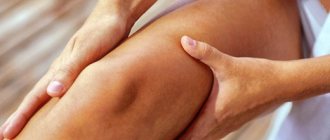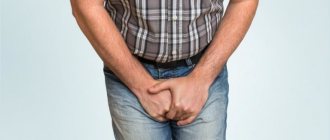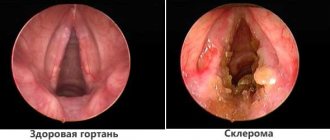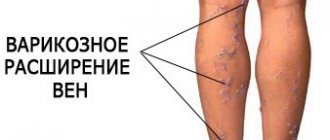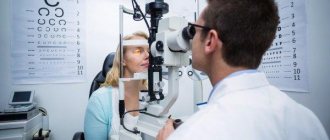Causes of pain in the hip and buttock
Patients experience hip pain for the following reasons:
- Inflammatory diseases. A distinctive feature is that the pain syndrome is characterized by constancy.
- Pain after exercise - walking, running. The main reason for such sensations is the development of deforming arthrosis, which occurs due to friction in the hip joint.
- Neurological pain. Feelings of goosebumps and tingling appear.
Spinal diseases
Diseases of the spinal column are often accompanied by pain in the legs and buttocks. Common pathologies:
- Osteochondrosis. Discomfort occurs in the buttocks, tailbone, and lower back. The sensitivity of the thigh decreases, and increased tone is observed in the buttocks.
- Intervertebral hernia. Pain occurs in the lower back and goes down to the buttocks and thighs. The patient feels them on the left or right. Possible problems with defecation and urination.
- Lumbosacral radiculitis. Movement in the legs is impaired, muscle weakness appears.
Spinal diseases lead to deformation of the affected structures, so they should be treated under the supervision of a doctor.
Purulent-inflammatory diseases
One of the reasons for pain in the thigh and buttocks is the development of abscesses and phlegmon. With abscesses, a cavity appears in the fatty tissue that fills with pus. Cellulitis has a diffuse character.
Osteomyelitis affects the bones. When the disease occurs, the patient experiences acute pelvic pain and dizziness. The infection enters the bone through the blood or through a wound.
A boil (furuncle) looks like a small cone-shaped swelling of a reddish color. It can go away without treatment quite quickly - within 7-10 days.
Injections
Often the pain after injections goes away on its own within a few minutes or hours. However, an abscess may develop at the site of drug administration if antiseptic rules are violated. The appearance of a bruise indicates that the needle has entered a small vessel. If swelling occurs under the skin, it means the drug was injected into fat and not into muscle.
Musculoskeletal disorders
Any deformation of the skeleton of the lower extremities affects many joints and bones. One of the causes of pain in the hips and buttocks is improper distribution of muscle tone in the lower extremity girdle. Other reasons:
- Flat feet – the disease disrupts the structure of the lower extremity belt.
- Congenital asymmetry of the pelvis - one half is larger than the other.
- Greek foot – lengthening of the second metatarsal bone.
Defects of the lower extremities can cause pain in the right or left thigh, as well as the buttocks.
Injuries
Often the thigh hurts in the back under the buttock due to bruises. The discomfort goes away on its own within a few days. Sharp pain in the buttocks and thigh also occurs when the hip is dislocated. The injured limb is in a forced unnatural position.
Fractures of the pelvis and lower extremities cause swelling, hemorrhage and severe pain in the hip.
Hip diseases
Common diseases of the pelvic joints include:
- Arthritis is inflammation of the synovial membrane of a joint. With rheumatoid arthritis, a person feels stiffness in movement in the morning. Psoriatic appears only during psoriasis.
- Arthrosis is the destruction of joint tissue. The main symptom is pain in the joint, which radiates to the thigh and buttock. At first it appears only while walking, then the intensity of the pain increases.
- Aseptic necrosis of the femoral head. The disease causes destruction and death of the head of the femur.
Diseases of the pelvic joints require complex treatment.
Circulatory disorders
One of the disorders is “long-term compartment syndrome.” If a person sits on a hard chair for a long time, the small vessels that supply blood to the buttocks become compressed. There is numbness in the thighs.
Malignant tumors
If the pain in the hips and buttocks is constant, cutting and stabbing in nature, the development of a malignant tumor is possible:
- Lymphosarcoma - affects the pelvic bones, causing pain in the pelvis and buttocks.
- Multiple myeloma is a blood cancer that causes bone damage.
- Tumors of the mammary glands that have metastasized to the hips and iliac bones.
- Osteosarcoma and osteoma are bone tumors that often develop from the hip.
Oncology can be fast-growing, so even if you experience minor but persistent pain, you should visit a doctor.
Why does it hurt in the back?
To answer this question, you need to understand how the buttocks and hips are structured. Their work involves several tissues and organs, violations of each of which can lead to painful sensations.
The first thought when pain occurs is the consequences of, perhaps, an old, not fully healed injury. Bruises and hematomas, as well as their consequences, are no less dangerous than degenerative diseases of the musculoskeletal system. But the following problems can also cause pain:
- purulent inflammation;
- negative changes in the circulatory system;
- pinched nerves;
- muscle pain;
- damage to ligaments or tendons;
- bone injury.
The pain can be different: nagging, sharp, aching. Pain in the gluteal region is a symptom that matches a very large number of diseases. Determining the exact location of the unpleasant sensations and their type will help you understand what kind of disease manifests itself in this way.
When does the pain appear?
Of great importance in diagnosis is the history of the disease, and more specifically, situations in which the pain intensifies or disappears altogether. When interviewing a patient, doctors pay attention to the time of day when painful sensations reach their peak.
The appearance or intensification of pain when a person takes a sitting position indicates serious and dangerous diseases; without proper treatment they can lead to disability.
Pain can result from a number of diseases:
- Trochanteric bursitis is an inflammation of the joint capsule of the hip joint, which covers the trochanter of the femur. The joint capsule is filled with fluid, it is necessary to reduce friction during movement. Its inflammation is accompanied by an increase in edema and decreased mobility. The peak of pain occurs at night.
- Osteoarthritis of the hip joint is a disease in which the connective tissue of the joint is destroyed. Develops due to insufficient tissue nutrition, hormonal imbalances, and after injuries.
- Lesions of the spinal cord root lead to paralysis or partial paralysis, but in case of minor deviations, pain, muscle flaccidity, and loss of sensation in the limbs will be felt. Damage to the nerves can lead to irreversible consequences.
- Gluteus minimus and medius syndrome – damage to the gluteal muscles as a result of injury, overload, or spinal disorders. Complications of intramuscular injections fall into the same category. Pain increases with changes in position.
- Radiculitis is a pinched spinal nerve. Mostly pain is in the back and neck, but in some cases it can be localized in the right gluteal and femoral region. With the disease, sensitivity may be impaired and weakness may be felt.
A physiological cause of pain in the muscles of the thighs and buttocks is also possible: after an active workout, lactic acid accumulates in the muscle fibers, and therefore aching pain may be observed in the next 2-5 days after exercise.
Some diseases can be identified directly by the type of pain:
- Acute pain indicates an acute onset or exacerbation of the disease; immediate treatment is necessary. Possible causes may be arthrosis, sciatica, and arterial damage. There is acute pain due to intervertebral hernia.
- Aching most often speaks of chronic inflammation; the severity of the pain is not as great as during an exacerbation, and patients do not pay due attention to it, mistaking it for a consequence of physical activity.
Mild pain may even be a symptom of the following pathologies:
- spinal tumors;
- formation of a blood clot in a blood vessel;
- arthrosis.
This symptom is also typical for sprains, bruises and minor injuries.
Associated symptoms
Most likely, pain in the leg is not the only symptom; others appear against its background. The signs may not be so pronounced, but by paying due attention to them, you will be able to more accurately determine the diagnosis.
Some symptoms that may occur in conjunction with pain and the diseases to which they relate:
- Muscle weakness. Muscles can not only weaken, but also atrophy, gradually becoming smaller. This symptom is characteristic of osteochondrosis, radiculitis, and can appear in pregnant women and due to impaired blood flow to the muscles (thrombosis, anemia). Atrophy develops over a long period of time.
- Decreased sensitivity is characteristic of damage to the nervous system. This can happen during an injury if blood vessels, hematoma or tumor (herniated disc) put pressure on the femoral and sciatic nerves.
- Frequent urination along with dull pain indicates the development of pyelonephritis or polycystic kidney disease. These diseases also cause headaches, weakness and constant thirst due to lack of fluid.
Gradually increasing pain may indicate the formation of a malignant or benign tumor. The symptom may also be a sign of blood cancer.
Fractures, dislocations, and sprains may not be noticed immediately after a fall or mechanical impact, but may be mistaken for an ordinary bruise. If the pain does not go away for a long time, and the symptoms increase, a diagnosis is necessary.
Diagnostics
No highly qualified specialist will make an accurate diagnosis without examination. After making a diagnosis and determining the causes of the disease, correct, individual treatment can be prescribed.
Important! The doctor can immediately, without diagnosis, prescribe painkillers.
The most common type of diagnosis is radiography; it can reveal damage to bones and joints, but this procedure will not reveal soft tissue disorders; ultrasound will help with this. CT and MRI are quite expensive procedures, but they provide a complete picture of what is happening at the location of the pain.
General tests of urine, blood, and stool are also prescribed. In some cases, invasive diagnostic methods such as biopsy and arthroscopy may be required.
For reference! In general, the treatment of diseases of the musculoskeletal system is extremely complex and requires a long period.
The general principles of treatment are to reduce mobility. If a degenerative-dystrophic change in the joint is detected, an orthosis is applied. In case of inflammation, NSAIDs are indicated; if the cause of the malaise is associated with an infectious lesion, then antibacterial drugs will be required. To recover from illness, massages, exercise therapy and physiotherapy are prescribed.
Source: LechimSustavy.ru
Symptoms that may indicate serious health problems
In addition to pain in the buttock and thigh, accompanying symptoms may appear that indicate a life-threatening condition. If a person experiences the following symptoms, they should immediately contact a medical facility:
- severe intestinal resistance and bloody stools;
- weakness in the legs or inability to move independently;
- paralysis in the thigh.
Pain in the buttocks and thighs in women often appears during pregnancy.
Recommended Treatments
Treatment methods depend on the affected area.
1. For furunculosis and ecthyma it is necessary:
- treating the skin around the boil with an alcohol antiseptic;
- local antibiotic dressings;
- taking antibiotics by mouth;
- taking B vitamins, sulfur, yeast.
2. For panniculitis:
- glucocorticoids and cytostatics;
- NSAIDs (Nimesulide, Ketoprofen, Meloxicam);
- UHF therapy;
- taking antioxidants (ascorbic acid, selenium, vitamins A and E).
3. For the treatment of muscle tissue diseases, the following is used:
- NSAIDs externally and internally (Diclofenac, Aceclofenac, Nimesulide, etc.);
- therapeutic massage and physical therapy;
- blockade with Novocaine or Diprospan;
- muscle relaxants: Mydocalm, Sirdalud.
4. For tuberculosis you need:
- complete peace;
- taking anti-tuberculosis drugs;
- prescription of vitamins and minerals in large doses;
- helio- and aerotherapy;
- endoprosthetics (if necessary).
5. For synovitis and bursitis, the following is prescribed:
- taking antibiotics (Vilprafen, Tsifran, Tetracycline);
- external non-steroidal anti-inflammatory ointments (Ketonal, Voltaren, Finalgel);
- if necessary, a puncture is performed to remove fluid;
- a plaster cast is applied to restrict movement;
- carry out physiotherapy (electrophoresis, magnetic therapy).
6. The most common disease that causes pain in the pelvic area and buttocks is osteochondrosis. Its treatment requires an integrated approach:
- prescribing NSAIDs, especially in the acute period (suppositories, ointments and tablets are used in combination);
- Sirdalud, Mydocalm are used to relieve spasms;
- to restore blood circulation in pinched areas, vascular drugs are used (Actovegin, Cerebrolysin, Cavinton);
- if the pain does not stop, antidepressants are prescribed;
- when nerves are pinched, massage is necessary to relax;
- for osteochondrosis in the lumbar region and pain in the buttocks and hips, a lumbosacral bandage is used;
- When the acute period is over, you can do exercise therapy.
7. For degenerative joint diseases (arthrosis):
- chondroprotectors are used (Teraflex, Artra) to provide nutrition to the joint and slow down the destruction of cartilage;
- NSAIDs are prescribed to relieve inflammation;
- to maintain blood circulation in the joint, vascular drugs are needed (Vinpocetine, Cortexin);
- Physical therapy is required.
If the buttock area hurts for no reason, you can take a combined painkiller: Pentalgin, Tempalgin, Novigan.
If the pain does not go away or recurs, this is a reason to visit a doctor.
Diagnosis and treatment
In the absence of injury and additional discomfort in the lower back, an MRI of the lumbosacral region is performed. When there is a suspicion of coxarthrosis, you should consult a surgeon.
To provide first aid for pain in the hip and buttock, you do not need to have special knowledge. Before the ambulance arrives, the sick limbs are provided with complete rest, and the person is given painkillers. If tissue swelling occurs, you can relieve the condition with cold compresses. If there is no inflammation, you can use warming compounds and perform a light massage.
How to get rid of pain?
The specific treatment for pain in the gluteal region depends on the nature of the pathology. Most often this is a conservative method. However, there are cases when specialists have no choice but to resort to surgical intervention. So, ulcers and boils are often removed.
If the pain is a consequence of a bruise or physical strain, treatment can be carried out independently. To do this, it is enough to use warming gels or ointments to warm the muscles. You can just relax or have a massage, as you can read in the article: “Features of buttock massage.”
If the pain in the buttock is severe, does not go away, and is also accompanied by other manifestations, the patient should urgently consult a doctor. Only a professional will prescribe the correct treatment.
Osteochondrosis
With degenerative-dystrophic damage to the vertebral discs, muscle atrophy , acute pain in the back and hip, and disturbances in the functioning of internal organs occur. Development factors are: uneven load on the spine and flat feet, a sedentary lifestyle and excess weight, prolonged exposure to an incorrect position and traumatic injuries.
At the first stage of the occurrence of pathological processes in the body, patients do not feel them, which leads to a decrease in the intervertebral space, dehydration of the disc and the appearance of cracks in the fibrous ring.
Irina Martynova. Graduated from Voronezh State Medical University named after. N.N. Burdenko. Clinical resident and neurologist of the Moscow Polyclinic. Ask a question>>
This leads to stiffness in movement, numbness or muscle spasms, pain in the back of the thigh and problems with sex life.
To determine the stage of development of the disease, x-rays and myelography, MRI and computed tomography are performed. Only after this, drug treatment and physiotherapeutic procedures, physical therapy and massage are prescribed. It is necessary to adhere to a diet, sleep only on an orthopedic mattress, wear comfortable shoes and clothes.
Possible diseases
To make a diagnosis, consultation with a dermatologist, orthopedist, neurologist or surgeon is necessary. Depending on the depth and location of the lesion, the pain will vary in intensity, but it can be caused by any disease.
Skin pathologies
- Furunculosis. Damage to the hair follicle causes a purulent-necrotic process. Severe pain and hyperthermia appear.
- Ecthyma is a streptococcal skin disease. A bubble with purulent contents appears on the buttock. The scarring process lasts 3 weeks and the pain disappears.
- Panniculitis is a pathology of subcutaneous fat. Discomfort and swelling appear, because... blood vessels are compressed by plaque.
Damage to muscle tissue
- Myositis. Pathology appears when blood vessels in the buttocks are compressed. The back of the thigh hurts when pressed, when moving, and often reacts to changes in weather. Myositis can lead to muscle atrophy.
- Piriformis syndrome. Occurs when there is inflammation of the lumbar or sacral roots, which put pressure on the sciatic nerve. Symptoms of radiculitis appear. Hips, lower back, legs hurt.
Damage to nerve tissue
Sciatica occurs. The difficulty of making a diagnosis is that the pain can be of a different nature. The lumbago appears on both the right and left sides. With sciatica, there is a feeling of numbness and burning in the legs. The pain is burning, aching, pulling.
Damage to the hip joint
- Osteo- or coxarthrosis. Gradual destruction of cartilage, stiffness in joint movement appears.
- Tuberculosis. With tuberculosis of the hip joint, cartilage and bone tissue are gradually destroyed. Muscle tone in the gluteal region decreases, muscle contracture and lameness appear.
Other lesions of joint tissues
- Synovitis is inflammation of the synovial membrane. Characterized by muscle spasm and pain inside the gluteal muscle, the joint swells.
- Bursitis is an inflammatory process in the synovial bursa of the hip joint. Characterized by pain when walking on the right or left.
- Injuries to the buttock area.
- Lymphosarcoma.
- Osteomyelitis is an infection that affects the bone.
Muscle pain after exercise
Daily activities that place severe stress on the hip joint or excessive active movement lead to overload of the ligaments, muscles and tendons .
Aching pain may appear for some time on the side of spasms of inflamed muscles or articular surfaces. Regular training, warm-up exercises and dosed exercise will help avoid pain.
Warming ointments or warm baths will help relieve pain on the back of the thigh; for tissue swelling, applying ice and homemade painkillers (ibuprofen, aspirin, etc.).
Arthrosis
Over time, worn-out hip joints cannot cope with their primary shock-absorbing purpose.
They begin to hit each other during movement, causing nagging pain in the back of the thigh and making it difficult to move. Arthrosis occurs at any age due to injuries and illnesses, strong physical impacts, constant stress on the joints during sedentary or standing work, hormonal imbalance and due to hereditary factors. Treatment is determined by a rheumatologist or orthopedist after full laboratory tests and x-rays. Chondroprotectors, painkillers, vascular and anti-inflammatory drugs, electrophoresis and ultrasound, physiotherapy and microwave therapy are prescribed.
In some cases, surgery may be required to install a prosthesis or introduce synthetic lubricant.
Piriformis syndrome
A pinched sciatic nerve can cause severe aching pain , numbness in the legs and weakness of the entire body.
This syndrome can occur with muscle overload, trauma and damage, lumbar stenosis and hypothermia. Diagnosis is based on tomography and x-rays, manual tests and novocaine injection.
Comprehensive treatment of the causes and symptoms of the disease includes taking antispasmodics and painkillers, pharmaco- and laser puncture, massage and physical therapy.
Injuries
Vigorous activity places a lot of pressure from human weight on the hip joint .
It is protected from force load by ligaments, synovial bursae and muscles, which, when bruised, sprained or inflamed, are unable to function normally and immediately begin to hurt. Tears of the thigh muscle and partial ruptures of the biceps muscle are accompanied by a cracking sensation and increased sensitivity with the formation of a hematoma and severe pain. It is not recommended to ignore these symptoms, otherwise there may be serious health problems in the future that can lead to disability.
Any pain that lasts more than 3 days or worsens with movement should be examined by traumatologists for a quality diagnosis and treatment.
Bursitis
Previous injuries or overuse can cause irritation of the bursa in the gluteal muscle and pain when moving or performing certain activities. During rest, pain decreases or completely subsides. Therapeutic actions will be aimed at stretching the muscles along the back of the thigh and gluteal muscles.
It is necessary to follow all doctor’s prescriptions and prevent subsequent injury to the bursa.
Causes of pain
In most cases, pain in the buttocks, radiating to the left or right leg, appears with osteochondrosis and osteoarthrosis. Between the vertebrae L4 and L5 of the lumbar spine and the vertebrae L5–S1 of the sacrum there are nerve roots that, when pinched or herniated, innervate pain or weakness through the buttock to the outer thigh, through the calf muscle to the front or back of the leg, causing numbness in the fingers or the outer thigh. parts of the foot. If you lift your big toe, you feel weakness in the entire lower limb.
The appearance of pain can be triggered by the following factors:
- hypothermia - general or lumbar;
- infections;
- sedentary lifestyle;
- metabolic disease;
- excess weight;
- injuries to muscles and ligaments, including old ones, received long before the onset of pain.
After a fall on the buttocks, the muscle fibers in the bruised area are gradually replaced by a connective tissue scar. Over time, it begins to compress the sciatic nerve, causing pain. Nagging pain not associated with diseases can appear in the following conditions:
- weather sensitivity;
- overwork;
- pregnancy;
- rapid growth in adolescence.
When should you seek immediate medical attention?
Pain is only a reflection of a symptom that indicates the development of the disease. It is necessary to listen carefully to the state of your body and promptly seek qualified advice from specialists. This is especially important when acute pain is accompanied by decreased mobility, swelling and redness of the painful area, fever, dizziness or loss of consciousness.
Only a qualified doctor can correctly determine the diagnosis and prescribe appropriate treatment.
And the sooner this is done, the less damage to muscles and joints will be and the lower the risk of the disease becoming chronic, and the less likely the need for surgical intervention will arise.
My leg hurts from hip to knee. Very often a person does not pay attention to such a symptom, considering it frivolous. But any discomfort in the body is a signal from the body about a problem; it is wrong to ignore it.
What to do if your leg hurts from the buttock to the back of the knee
Pain in the leg from the buttock to the back of the knee is explained by various reasons. It all depends on the location, the nature of the sensations, and accompanying symptoms. It is impossible to independently diagnose yourself in such a situation. You should take tests and undergo a hardware examination.
Causes of nagging pain
A nagging pain usually manifests itself during squats or walking up the stairs. An unpleasant pain syndrome sometimes radiates to the bone behind or in front, on the left or right side. Possible causes of discomfort:
- Injuries to soft tissues and bones: bruises, fractures, sprains, torn ligaments.
- Inflammatory processes in soft tissues and bones: purulent infection, myositis, osteoporosis, aseptic necrosis, bone tuberculosis, osteomyelitis, etc.
- Damage to bones and soft tissues by a tumor: leukemia, various types of sarcoma, metastases of a malignant tumor in the thigh.
- Joint damage: fractures, arthritis, arthrosis.
- Diseases of the veins and arteries: thrombophlebitis, venous insufficiency, varicose veins, thrombosis.
- Damage to the nervous system: trauma, spinal tumors, osteochondrosis, neuritis.
Associated symptoms
Pulling pain from the back of the buttock to the knee is often accompanied by other signs:
- Swelling is a sign of an inflammatory process, traumatic injury to the knee, or a disorder of the cardiovascular system.
- Loss of sensitivity and numbness, goosebumps. Indicate problems of the nervous system.
- Change in skin color. Caused by thrombophlebitis, varicose veins, formation of pus, inflammation. Redness can be streaky or focal.
- An increase in body temperature is one of the main signs of inflammation.
Additional signs help determine the cause of nagging pain and prescribe effective treatment.
Diagnostic principles
A comprehensive examination allows you to make an accurate diagnosis and determine the characteristics of therapy.
- Examination and consultation with a doctor. The specialist learns all the patient’s complaints, examines the sore leg, and studies the medical history. Consultation allows you to identify the preliminary cause of pain.
- Biochemical and general blood test. The composition of the blood allows you to learn about inflammatory and purulent processes, lack of nutrients, and assess the condition of internal organs.
- Instrumental methods of examination. Required for final diagnosis. Most often, ultrasound and x-rays are prescribed.
Treatment of nagging pain from hip to knee
If the leg is pulled from the buttock to the knee for a long time, treatment cannot be delayed. Therapy is primarily aimed at the underlying disease. It includes medications appropriate to the disease and symptoms, physiotherapy, and exercise therapy. In extreme advanced cases, surgery is performed.
As additional remedies, the doctor may recommend:
- Folk remedies. Strengthens blood vessels, joints, and general condition. Recipes are selected individually depending on the pathology.
- Foot baths with herbs. Eliminate pain, tension and fatigue. It is recommended to add sea salt to increase effectiveness.
- Compresses. Relieves swelling, inflammation, reduces pain. The composition is selected according to needs. Additionally, the leg is insulated with a special film and warm fabric. The compress is left for several hours, and sometimes overnight.
Diseases that cause hip pain
Unpleasant sensations in the hip do not always mean that the cause is in the leg itself. In the human body there are a huge number of nerve fibers intertwined with each other, so pain in the leg from the hip to the knee can manifest itself, for example, problems in the back.
To illustrate how serious leg problems can be, we can recall one typical clinical case. A patient who had been suffering from pain in her leg for six months consulted a traumatologist. The pain begins behind the knee, passes through the thigh and reaches the buttock, and is sharp and pulling. It all started after the patient went to the gym, where she did squats with a barbell. The woman had no injuries or injuries. The doctor at the local clinic ordered the following tests for her:
- MRI of the lumbar spine;
- Ultrasound of the knee joint;
- photo of the bone.
The examinations did not reveal any pathologies. The doctor prescribed the following treatment regimen:
- course of Nise tablets;
- Diclofenac ointment.
But the treatment did not bring relief to the woman. It was decided to look for the cause in the spine. During the examination, an intervertebral hernia was found, which radiated sharp and aching pain in the leg from the hip to the knee.
Fact! Such cases are not isolated and clearly show that pain in the right leg is not always a consequence of a problem in the leg itself.
Discomfort from the hip to the knee may occur for the following reasons:
- damage to soft tissues;
- hip injuries and fractures;
- muscle inflammation;
- tumor processes;
- systemic joint diseases;
- varicose veins;
- arterial damage;
- diseases of the spine;
- overstrain of the thigh muscles after physical activity.
There are quite a few reasons, each requiring a separate examination and a serious approach.
Spine pathologies
Age-related changes in the intervertebral discs are often reflected by hip pain. At the same time, it is aching in nature and is accompanied by lower back pain and cramps.
Important! If you experience any pain in your leg, you should immediately consult a specialist and do not try to cure it yourself. The disease can be greatly aggravated.
A pathology such as osteochondrosis is often detected in childhood, since modern children spend most of their time with gadgets in their hands and do not always pay attention to the posture in which they sit, and play little outdoor games. Therefore, more and more often, parents hear when examined by a doctor that their child has scoliosis. The next stage of scoliosis is osteochondrosis.
Prevention
To avoid the appearance of chronic pain in the lower back, gluteal region on the right or left, spreading to the legs, you need to adhere to the following rules:
- when working at a computer for a long time or standing on your feet, take breaks, stretch your legs and lower back (this also applies to drivers who are forced to drive for a long time);
- sit on a chair with a high back; you can place a bolster under your lower back;
- do not slouch, watch your posture;
- If possible, avoid severe physical exertion and hypothermia;
- monitor your own weight;
- do not wear shoes with heels higher than 4-7 cm;
- give up bad habits and lead a healthy lifestyle;
- sleep on a moderately hard bed (the best option would be an orthopedic mattress);
- undergo regular preventive examinations with a doctor.
In 95% of cases, lumbar sciatica has a favorable prognosis. With timely treatment and compliance with preventive measures, pain in the buttock radiating to the leg and other unpleasant manifestations of the disease can be eliminated without a trace.
Source pomogispine.com
Associated symptoms to watch out for
For an accurate diagnosis, patients should be told about all accompanying symptoms:
- Swelling, even minor. May be the result of injury or inflammation.
- Numbness of the skin. It happens with some diseases of the nerve fibers.
- Spots on the skin accompanied by pain may indicate thrombophlebitis.
- Increased body temperature.
- Seal. May be a sign of cancer.
All symptoms can occur individually or together. For example, signs of a purulent process in the leg are:
- skin redness;
- rash;
- temperature increase;
- edema.
The same symptoms can occur with a fracture, joint or muscle damage.
Important! It should be remembered that after an injury, some symptoms do not appear immediately.
When the pain is localized above the buttocks
Pain above the buttocks is characteristic of some types of paraproctitis - ischiorectal or pelviorectal abscesses. These pathologies can be distinguished from each other only after an examination performed by a proctologist or surgeon. This:
- examination of lesions on the skin;
- digital examination of the rectum;
- Ultrasound with a rectal sensor;
- anoscopy - examination of the rectum from the inside using an optical device with a camera;
- sigmoidoscopy - examination of the rectum and sigmoid colon using a longer, rigid device than in the previous case;
- in the presence of fistulas, a test with dyes is carried out: methylene blue is injected into the fistula opening and observed where it begins to be released. If the dye leaks from the rectum, its internal opening is located using an anoscope;
- fistulography. It consists of introducing an X-ray contrast agent into the fistula, followed by taking an X-ray in several projections.
The last 2 methods enable the proctologist to determine the scope of the operation.
Hip pain in a child
When leg pain occurs in an adult, especially in adulthood, the most common cause is age-related changes, but when it occurs in a child, there are several reasons:
- Synovitis is an inflammation of the hip joint that occurs as a complication after viral diseases. Characterized by pulling the leg in front. It usually goes away on its own without consequences, but in rare cases it may be necessary to drain fluid from the joint.
- Arthritis. To recognize it, you need to pay attention to such accompanying symptoms as swelling in the leg, in the joint area, fever, rash. The leg begins to hurt after sleep, subsequently pain appears, radiating up and down.
- Prolapse of the femoral head from the hip joint. It is accompanied by sharp, unbearable pain, as the nerves are pinched and requires immediate attention to the emergency room. An x-ray may be needed to rule out a fracture.
As a rule, if parents go to the hospital in a timely manner and receive proper treatment, the causes of hip pain in children will be determined, and the discomfort will go away without consequences.
There is only one conclusion - the pain cannot be tolerated; you should immediately consult a doctor to examine its causes. The complexity of treatment, as well as its cost, will depend on the speed of making the correct diagnosis.
If you find an error, please select a piece of text and press Ctrl+Enter.
Reason 2. Inflammatory processes
Abscesses are the appearance of cavities filled with pus. They begin to hurt in the buttock if they are located there. Treatment for this disease involves taking antibacterial drugs. Most often they have to be removed surgically.
Cellulitis or diffuse subcutaneous inflammation of adipose tissue. It can form in both the left and right buttock. In this case, unbearable pain is especially acute when sitting. Along with painful sensations, body temperature rises, swelling appears at the site of inflammation.
Read on our website
Osteomyelitis is a disease that affects human bones. It is purulent-inflammatory. And if the disease affects the bones of the hip, then the pain radiates not only to the leg, but also to the buttock. At the same time, it is sharp and sharp in nature, making it difficult to move when walking.
Even sitting can be very difficult. There is a deterioration in health: headaches appear, nausea occurs, the temperature rises, and consciousness is disturbed. In some cases, the patient may even fall into a coma. Treatment of the disease is carried out by specialists exclusively in a hospital setting.
We suggest you read: How to reduce swelling and a bruise under the eye after a blow
The causes of such pain are often boils. They very often appear in that area. Outwardly, they look like cone-shaped elevations; in their center there is a purulent core. Depending on the size of the boil, the pain in the buttock will be very severe or not very painful.
Read about how to get rid of acne on the buttocks in the article located at the link.
